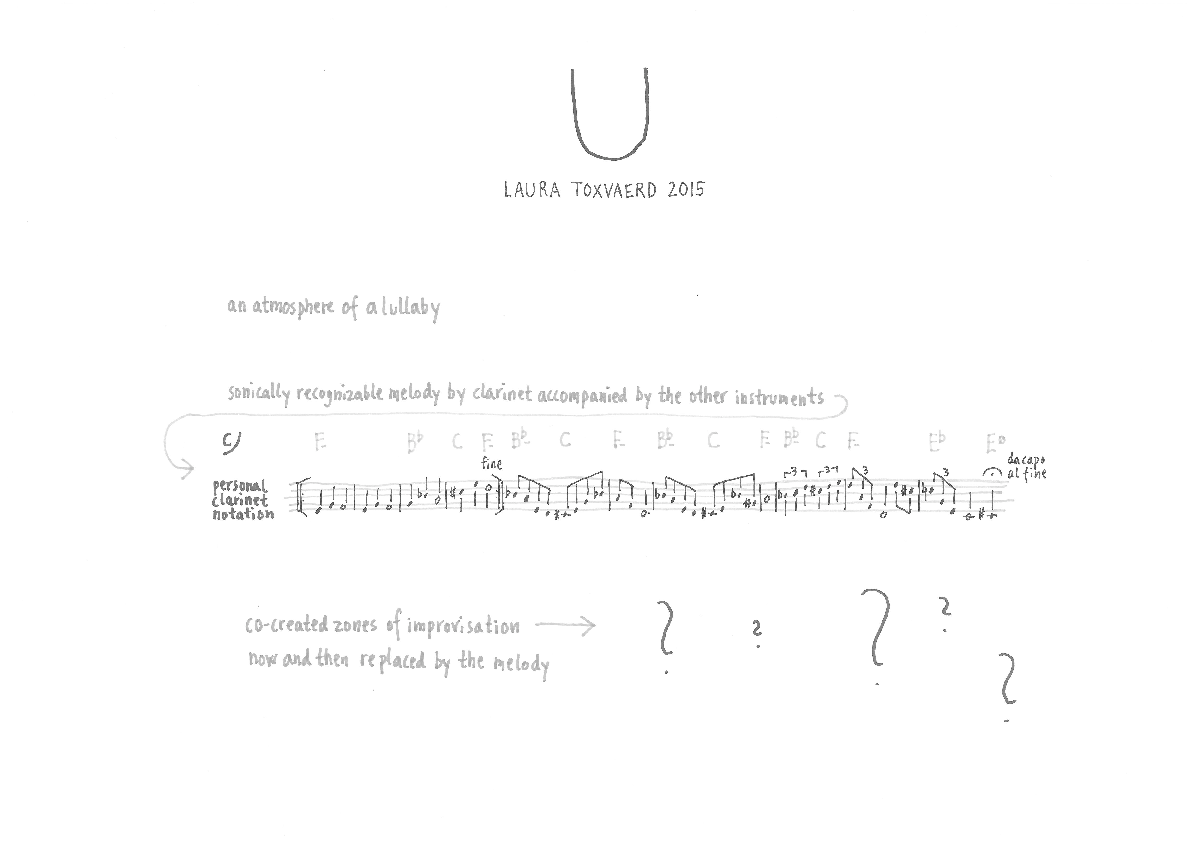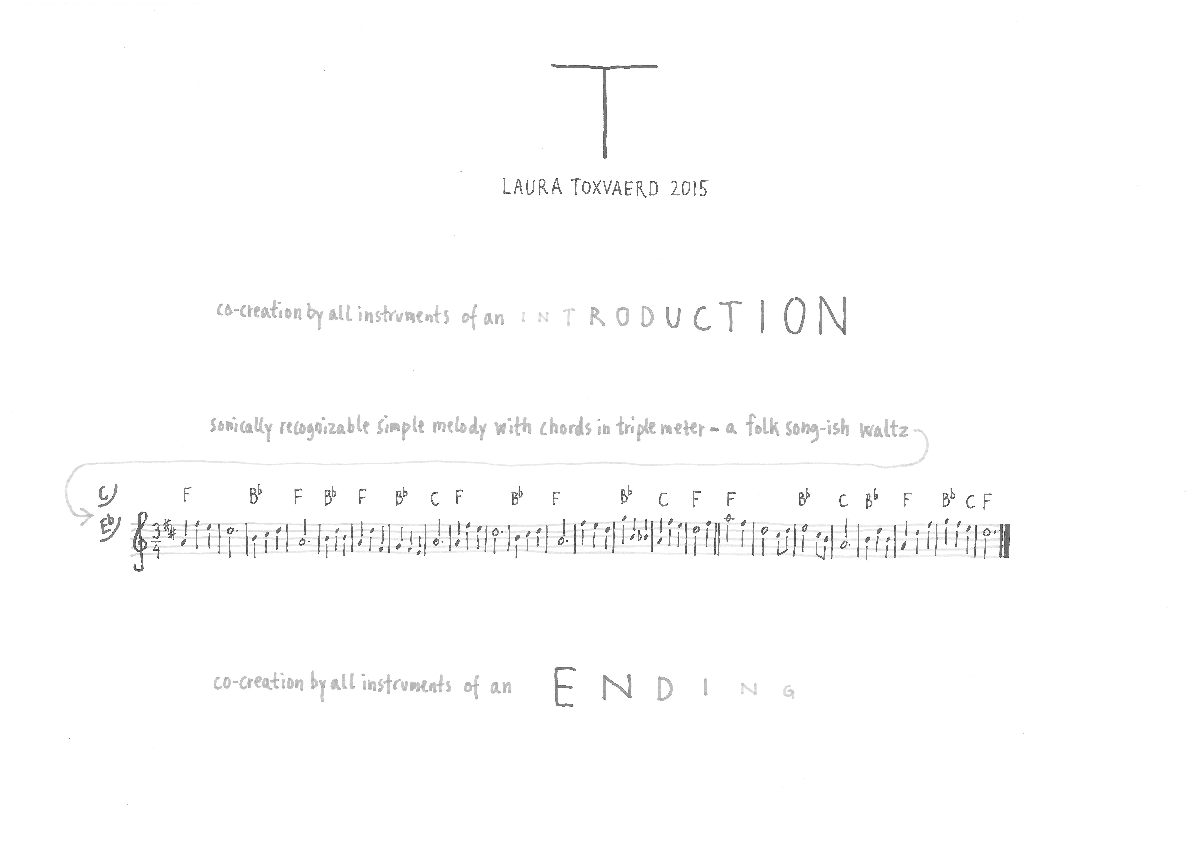When I composed Q my plan was that the co-creation by the bass and the drums would be manifested as an improvised “almost groove/nearly time”, while the alto saxophone and the piano would play sonically recognizable fragments in the form of a rubato-articulated melody with accompanying chords. In this way, the composition would come to have a sonic character that one would recognize after hearing it only once. In addition, there would be the clear manifestation of an element of the improvising musicians’ co-creation of the composition.
Because the aim was expressly to create an “almost groove/ nearly time”, it was never my plan that this aspect of the piece would be constituted by the bassist’s and the drummer’s totally free co-creation. What I mean by the use of the term “almost groove” is that the groove should not be coordinated exactly rhythmically between these two players. It should be a little messy but still give the impression that a real groove could possibly come into play. But, it never actually enters. In jazz and in other kinds of rhythmic music, “playing in time” means that you could (almost) have a metronome ticking and it would fit with what the musicians are playing. So when I use the term “nearly time”, this indicates that a ticking of a metronome would not precisely follow the pulse of the musicians’ playing – even though you might have a feeling that the musicians’ playing nearly followed a metronomic pulse.
My prior thoughts on the composition also had something to do with splitting the ensemble into two separate spaces of sound. I wanted the alto saxophonist and the pianist to interact with each other in one group. In the other group, the bassist and the drummer should interact. But, I wanted no interactions between the two groups.
When I composed S, I thought that I would have some sonically recognizable elements in the various forms of a metronomic groove, played by bass and drums, and a saxophone riff that was connected to that pulse. By the term “riff”, I mean to indicate a short and catchy melody line. This line should be repeated multiple times and each repetition should have the length of five beats.
Besides this, I wanted the pianist to be slowly flowing, with harmonies that stand in a non-metronomic relation to what the other instruments were playing. And “what the other instruments were playing” includes both the alto saxophone’s short repeated melody and the bass/drum-groove.
I was aware that the repetition of the alto saxophone’s line would, on the one hand, be enervating but that, on the other hand, it would express an insistent energy. One should get the feeling that it was a little bit too much, and that it continued for too long.
The pianist’s slowly flowing harmonies should be totally unaffected by the pushy alto saxophonist, and should simply play the harmonies in a relaxed and cheerful manner.
When I composed U I wanted to create an atmosphere of a lullaby. Zones of improvisations would now and then be replaced by a sonically recognizable melody played in the low register of the clarinet, accompanied by the pianist and the bassist – visiting the indicated harmonies – and the drummer. The improvising musicians were being called upon to co-determine which instruments were going to play in the different zones of improvisation.
The sound that a clarinet makes in its chalumeau register is quite different from any of the sounds that the alto saxophone can produce. Generally, the clarinet is warm and peaceful while the alto saxophone is bright and sharp.
When the instruments are compared in this way, they appear as contradictions. I thought that this new change of sound would stand as a variation that could influence the way that one would experience all of the compositions, as a whole, at the concert. A sudden change, from a bright and sharp sounding instrument to an instrument that sounded warmer and more peaceful would come as a surprise for the listener. But it would not be the typical surprise, where something wild suddenly breaks out from a peaceful place. Rather, it would be the opposite way around, where the overall norm of the concert could be characterized as most decidedly having an energized, dense and sharp musical atmosphere.
This situation would then come to be interrupted by this calming composition. Possibly, it would be perceived as a relief. And I liked that idea. That’s the reason that I chose to introduce the clarinet into this composition.
When I composed T, I wanted to bring forth a very simple melody, with chords, in triple meter, a melody that you would think you already knew, even though you were hearing it for the very first time.
I wanted the whole ensemble to join in, and naturally this Aylerian “folk song”-ish waltz would be the sonically recognizable element in the composition.
The improvising musicians were expressly asked to co-create an introduction and an ending to this melody.
My idea with composing V was to create a sonically recognizable dynamic development.
The volume of the music should move gradually from very loud to very quiet to very loud. And I wanted four interruptions of silences.
The co-creation by the improvising musicians would be to establish a texture of sounds with many activities in the first half of the composition, and a texture of sounds with few activities in the second half.
My plan when I composing R was to have lines of melodic material played by the alto saxo- phone“in the form of AABA” with a tonality in the B section that was different to the A section’s tonality. ‘A’ and ‘B’ had to have an uneven number of bars, but in such a discreet way that it would not feel odd.
This material should function as the sonically recognizable element in the composition. The pianist’s, the bassist’s and the drummer’s co-creating role was to play a “metronomic groove with random notes and chords”.
With regards to this groove, I thought that it should be rhythmically coordinated and felt in such a way that it would be possible to imagine a metronome ticking when it was played.
When it came to considerations about the form, I had no specific ideas.





